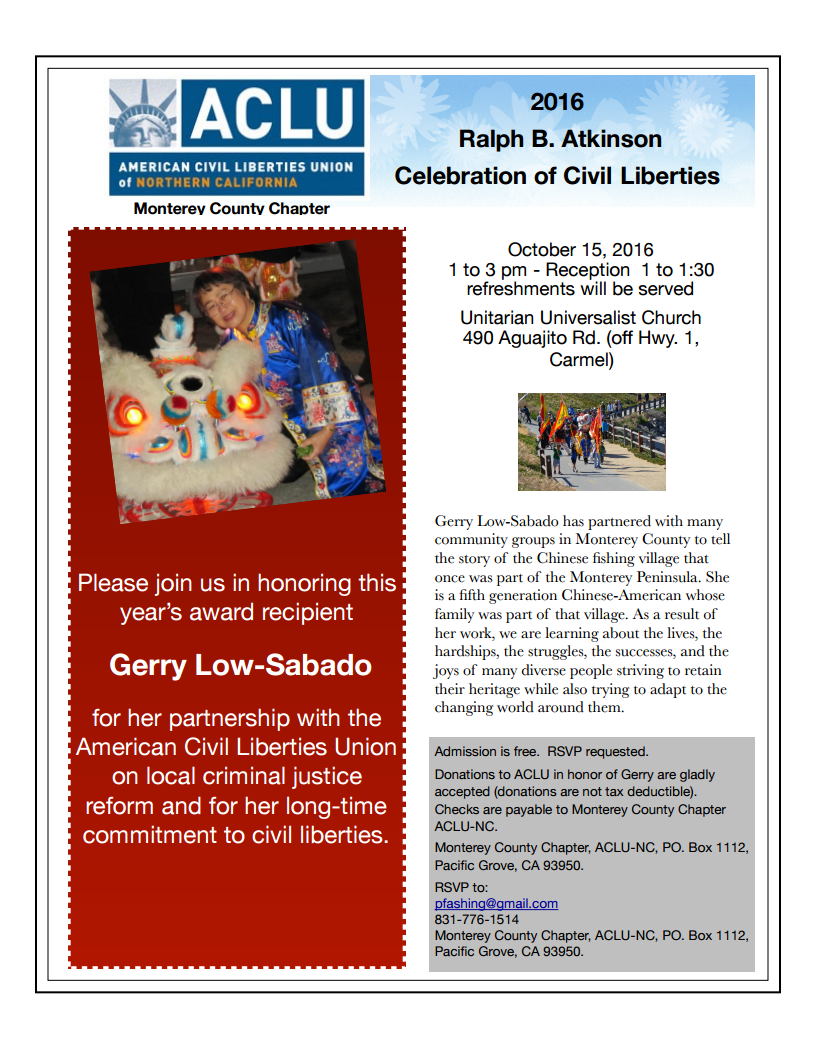Home » Stories
Category Archives: Stories
Marshall Gold Discovery State Historic Park To Dedicate a New Hiking Trail honoring Chinese American Forty-niners
February 3, 2022 3:51 pm / Leave a comment
On Friday February 11, 2022 Marshal Gold Discovery State Historic Park in Coloma will dedicate a new hiking named the “Gam Saan Trail”. The ribbon cutting ceremony and light lunch will take place at 11:00 am at Henningsen-Lotus Park. The name of the trail takes its inspiration from the Cantonese words “Gam Saan” which translates into “Gold Mountain” a term used to refer to America during the 19th century gold rush. The event is hosted by California State Parks, El Dorado County Parks, Chinese American Council of Scramento, Chinese Benevolent Association of Stockton, Gold Discovery Park Association, and The Locke Foundation.
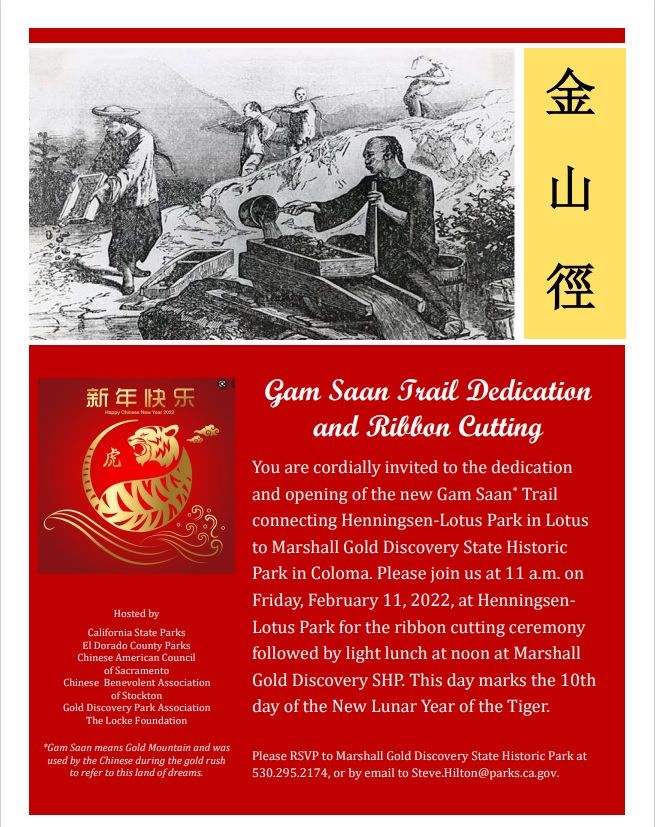
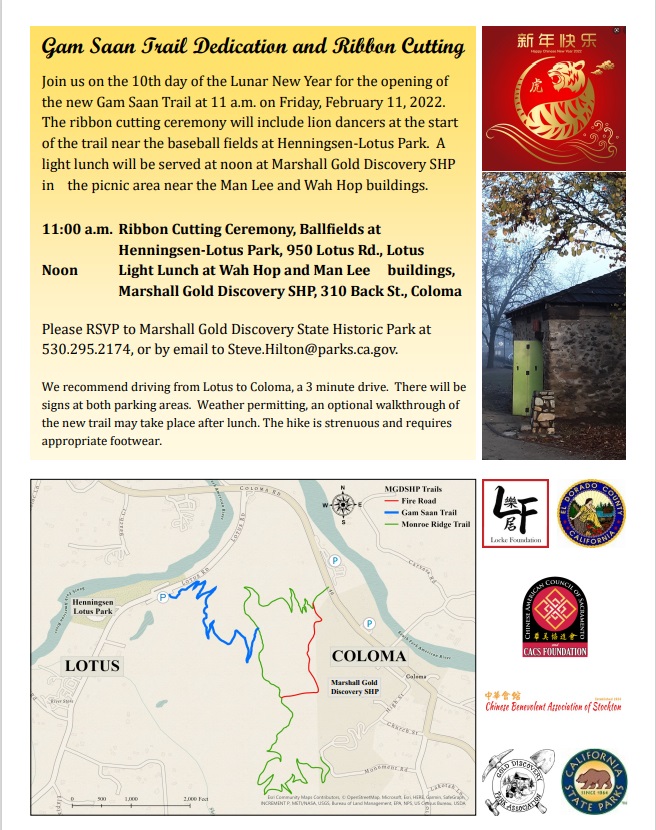
Travel the Trail of Chinese American Railroad Builders
November 4, 2018 2:06 pm / Leave a comment
The Chinese Railroad Workers Descendants Association (CRWDA) a national non-profit organization has organized for 2018 a guided tour that will take participants along the trails of 19th century Chinese Americcan railroad builders. In the mid 19th century, from 1864 to 1869 historians have estimated that more than 10,000 to upwards of 15,000 Chinese immigants were employed as construction workers on the building of the Central Pacific Railroad constructed length of the transcontinental railroad.
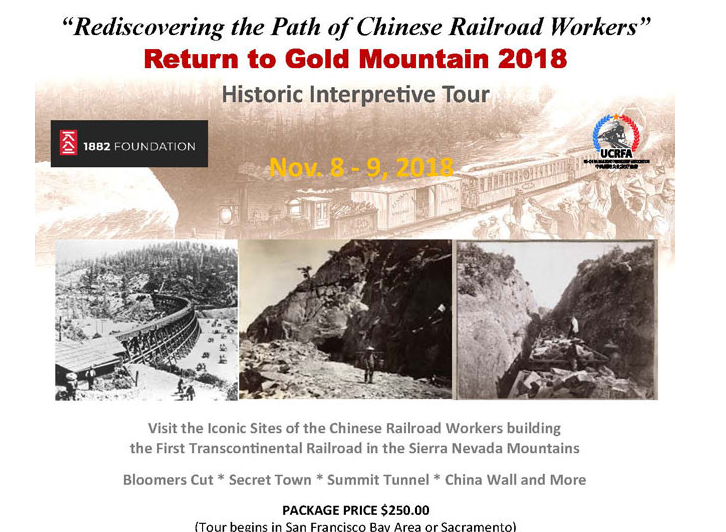
The latest email from event organizers included this announcement:
Just a reminder for those who have not registered for the 2019 Golden Spike conference that early bird registration will end on Wednesday, October 31, 2018. If you are planning on going, please be sure to purchase your registration before then. This is the last discount before full registration begins. Here is your cost breakdown:
Description Total
Bus Transport $150
Van Transport $90
Included Meals $500
Programming $200
Subtotal $940
TRCC GRADE TOUR $85
Total $1,025
Registration $600
SAVINGS $425
Early Bird Discount $100
Savings with Discount $525 (51% discount from cost)
For complete details go to http://http://goldenspike150.org
About the CRWDA: The Chinese Railroad Workers Descendants Association is a national, membership based, charitable organization which seeks to preserve, promote and protect the contributions made by Chinese railroad workers to the United States.
New Bay Area Project — Chinese American Pioneer Heritage Committee to Showcase Golden Spike History and Marysville
October 21, 2018 10:45 pm / Leave a comment
This fall a committee gathered to dicuss the creation of a new project to develop an event to coincide with the 2019 Marysville Bok Kai Festival scheduled for March 9-10, 2019. Detials for the early planning for this event is presented in announcement from the Chinese American Pioneer Heritage Committee.

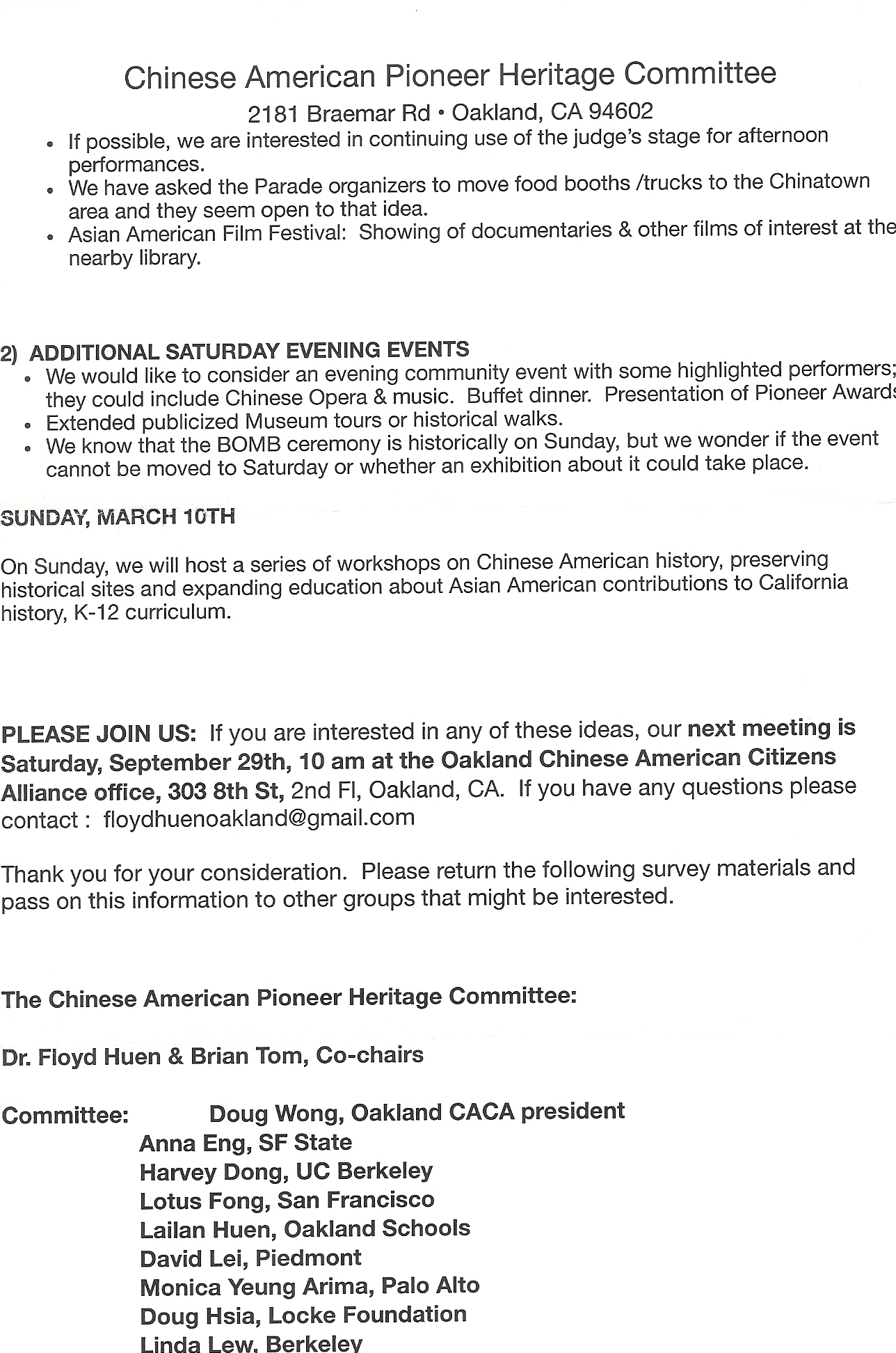
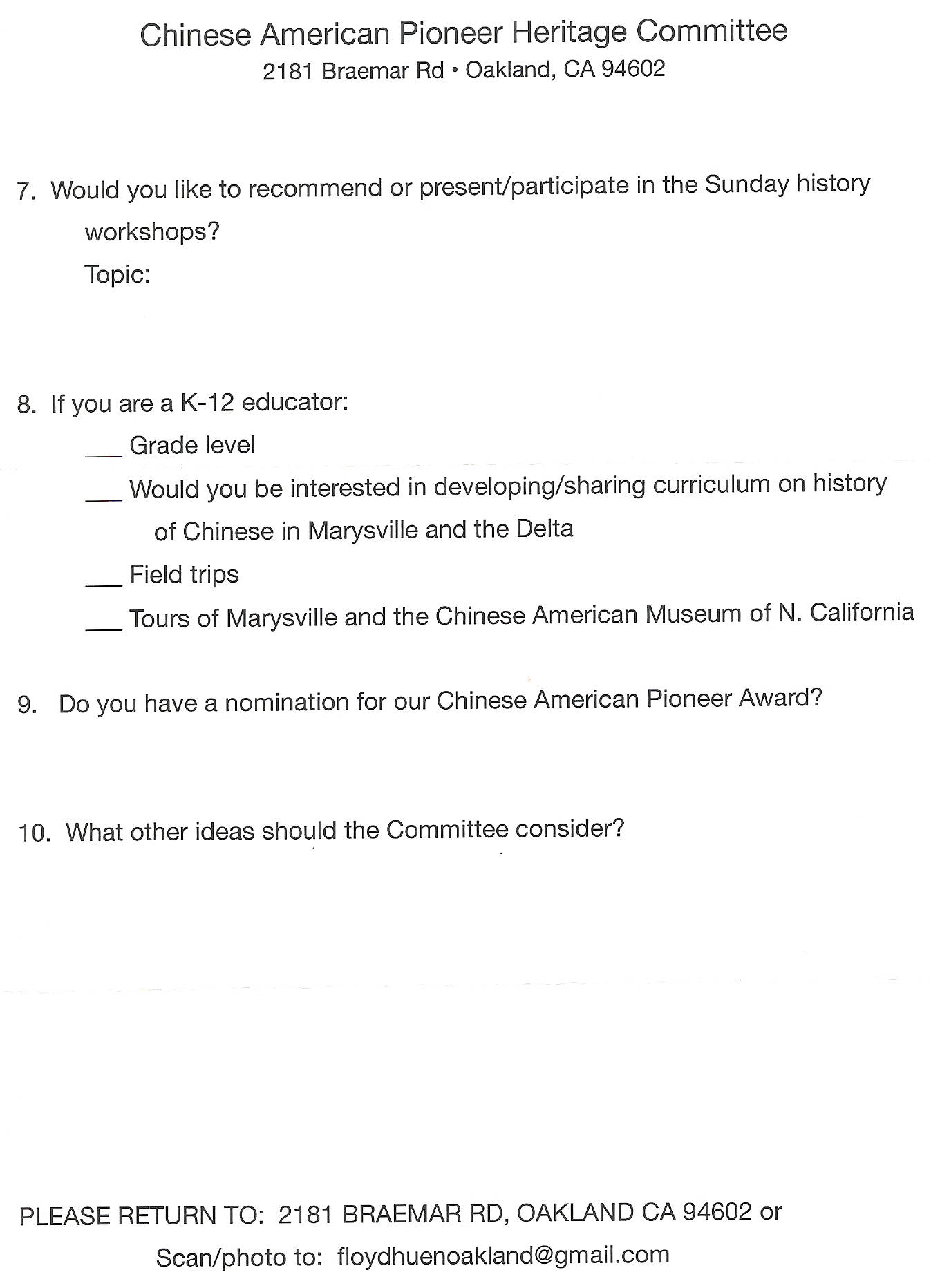
Walk of Remembrance: Celebrating Pacific Grove’s Chinese Village and Pioneering Fishing Community,May 6, 2017
April 27, 2017 10:30 am / Leave a comment
With Great Gratitude,

ACLU Awards Gerry Low-Sabado for her promoting awareness of Chinese Fishing village history in Monterey
October 23, 2016 12:04 pm / 2 Comments on ACLU Awards Gerry Low-Sabado for her promoting awareness of Chinese Fishing village history in Monterey
Tie Sing and Chinese American history comes alive at Sequoia National Park
December 21, 2014 8:44 pm / Leave a comment

Jordan Yee Interpretive Ranger at Sequoia National Park stars in his original 3 act one person play portraying the historical figure Tie Sing. Photo Credit: Tara Hosnick.

Stage Right recreates the Japanese lanterns that Tie Sing used to decorate the 1915 Mather Dinner’s banquet table in the forest. Center stage is Tie Sing’s worktable. Photo Credit Tara Hosnick.

On Stage Left is situated props recreating Tie Sing foldable pack stove, firewood, kayak bag, and cargo box. Photo Credit Tara Hosnick.
Byline Jordan G. Yee Seasonal Interpretive Ranger
On September 26 and 27 2014, the Beetle Rock Education Center located in Sequoia Kings Canyon National Park was the venue for two matinee performances of an exciting historical play titled “Tie Sing: Chef of the Mountains.” This hour long staged dramatic work was written and performed by Interpretive Park Ranger Jordan Yee. Each performance took enthusiastic audience members through an emotional and historical journey, replete with appealing characterizations, a compelling story arc, and a dramatic narrative that encompassed a close look at issues facing the nascent National Park Bureau, the early western national parks that lacked sufficient protection and guidance, as well as the impacts of the Chinese Exclusion Act which by 1915 had been in effect for 33 years.
The play written as part historical drama and part biographical drama, portrays the events, developments, and dynamics of the real Mather Mountain Party of 1915 where the National Park Service’s first director Stephen Mather planned and worked to enlist and harness the energy and devotion of a select band of powerful men. The play’s story arc follows Tie Sing, a Chinese American cook and 28 year veteran at running a field kitchen for the United States Geological Survey, who in 1915 who was specifically drafted by former United States Geological Survey (USGS) Chief Geographer Robert Marshall to cook for the Mather Mountain party of 1915. As the play opens, Tie Sing and his assistant Eugene are unpacking food and supplies in the Giant Forest in preparation for the first night’s dinner under the Sequoias. As in all good drama, the action and the plot are propelled forward by conflict. The play skillfully presents an engaging tale of Stephen Mather’s plan to achieve the objectives of winning the hearts and minds of the 18 powerful men on this pack trip through land that is now Sequoia National Park. Tie Sing and Eugene brilliantly fulfill their role of providing expert culinary experiences in the Giant Forest, making firm the body-mind connection by leveraging the power of “comfort food” to underscore the emotional dimensions of the cause of building up western parks and supporting them through a new “National Park Bureau.” As the play unfolds, Tie Sing and Eugene must contend with, among other things, a lost mule carrying vital supplies and ingredients, and a 300 foot fall down a cliff by a mule laden with key cooking utensils and gastronomic delicacies. Conflict extends beyond the matter of mules as Tie Sing and Eugene must battle the perceptions of the relative worth, or more accurately the perceived lack of worth generally assigned to cooking, as it was generally deemed “women’s work”, as well as hot button social issues of the day such as the Chinese Exclusion Act which had kept both Tie Sing and Eugene as single men unable to marry and start a family. As a counterpoint to this tension, in the play the role of food and especially food in its comforting role as an antidote to travelers facing travails on the road, a cure for homesickness, an unalterable emotional link to childhood, and a deep-seated human longing, is beautifully drawn.
Through three acts, the play re-lives the Mather Mountain Party mule pack trip of 1915. As the plot works its way along a route that begins in the Giant Forest of Sequoias to Mineral King, through the Franklin Pass, up Mt. Whitney and back to the final dinner of the trip, members of the Mather Mountain Party as a result of Tie Sing’s and Eugene’s hospitality and culinary artistry, proclaim Tie Sing “Philosopher of the Sierra” and “Gourmet of the Mountains.” The piece de resistance is Tie Sing’s special baked pastry that contained a personalized wish of good tiding for each dinner guest.
Written as a dramatic piece, the play also succeeds as a first person costumed interpretive presentation. Factual aspects of mule pack trips into the Sierras of the period, trail cooking, the dynamics of the Mather Mountain Party, as well as the historical context of the Chinese Exclusion Act and its pernicious effects on individual lives of Chinese Americans, are deftly interwoven in the dramatic fabric of the play.
Following each matinee performance, playwright and performer, Jordan Yee engaged audience members in a discussion of the play and the era it portrays. Eager questions from audience members indicated the degree to which audience members empathized with the portrayal of Tie Sing; “Did Tie Sing ever get married?”; “What was the influence of Chinese Americans on American cooking?
Dawn Ryan an Interpretive Ranger at SEKI who attended the 1st performance said the play “brings to light an important era in the creation of the National Parks as well as the unpleasant side of America’s history regarding the Chinese Exclusion Act that gets very little attention. Ranger Yee tells the compelling story of Tie Sing of the Mather Mountain Party, through a one person play that draws attention to the influence of Chinese immigrants on this country, the effects of the Exclusion Act on these people, and reminds us of how relevant it is to continue to tell these stories today. It’s a story that needs to be told!”
In 1915 Sequoia Kings Canyon National Park and its Giant Forest was the actual venue for the historical Mather Mountain Party of 1915. In 1890 the Chief of the United States Geology Survey – Mr. Robert Marshall named Sing Peak, a 10,552 foot mountain peak in the Sierras in honor of Tie Sing for the decade of service he had at that time provided the men of the USGS mapping teams, and as an indication of the esteem in which he held Tie Sing. In 1915 Marshall was a key figure in the planning and execution of the 1915 Mather Mountain Party.
Uncovering the history of Chinese American Contributions in Yosemite National Park.
August 15, 2014 7:08 pm / Leave a comment

22 hikers made it to the summit of Sing Peak during the 2014 Sing Peak Pilgrimage organized by the Chinese American Historical Society of Southern California. Photo Credit Jack Shu.
Byline Jordan G. Yee, Park Ranger Interpretation NPS
August 7, 2014
A large and enthusiastic turnout of visitors participated in interpretative talks, conducted hikes onto established trails and forgotten old roads, and attended other presentations offered by Yosemite National Park interpretive rangers, archeologists, landscape architects and guest speakers for 3 days at Yosemite for the 2014 “Sing Peak Pilgrimage: Contributions of Chinese Americans in Yosemite ” event. From July 25 to July 30th, 40-50 visitors visited the historic Tioga Road, the Washburn Wagon Road to the Mariposa Grove, 19th century mining and construction sites, as well as other places associated with the lasting contributions of Chinese Americans in Yosemite.
On Friday July 25, participants hailing from all over California as well as out-of-state hiked with Interpretive Ranger Yenyen Chan along portions of the Great Sierra Wagon Road near the current Tioga Road. The Tioga Road was constructed in 1882 to 1883 by a construction crew of 90 European Americans, and 250 Chinese Americans. For the blasting work on this road, a group of 100 Chinese American construction workers was used exclusively. The road, originally built for Great Sierra Consolidated Silver Company, was purchased and donated to the Government as part of Stephen Mather’s plan to improve public access to Yosemite National Park. Participating hikers, many who were members of the Chinese American Historical Society of Southern California (CHSSC) – a community organization based in Los Angeles that helped plan the 3 days of events with park staff, were particularly intrigued by the historic structures at Bennettville near Tioga Road.
On Saturday the 26th Archeologist Barbara Bane and Historical Landscape Architect Kevin McCardle led hikers along sections of the historic Washburn Wagon Road built in 1879 and located near the park’s southern entrance. Hikers were energetic and in high spirits despite the mosquitoes and heavy brush growing on the intact and structurally sound old road, as they rediscovered the paths of the road. Hikers were keen to see up close historic road cut blast sites, as well as the dry laid retaining walls constructed from blasted and salvaged field stone. Archeologist Bane told the group that the economical and expert construction of the retaining walls and roadbed construction using blast rubble displayed the high degree of skill of the construction crews. The techniques and skills used in the construction resulted in a road that though built 130 years ago is still stable and firm. Similar roads near Glacier Point Road, also believed to have been built by Chinese American construction crews easily supported the wildfire engines traversing portions of the old forgotten road in recent years when responding to a wild fire. Historical Landscape Architect McCardle noted, specific design features and construction techniques indicate a strong link to traditional stone wall construction found in China and other walls in and around that park attributed to Chinese construction crews. Following the morning hike, children’s author Annette Pimentel recounted to audiences her experiences in research the life of Tie Sing for her forthcoming children’s book on Tie Sing who has been hailed as “gourmet chef of the Sierra”.
A dinner was hosted by the CHSSC where Interpretive Ranger John Jackson, who coordinated the event with the CHSSC, presented a campfire program to conclude the days’ events. On Sunday hikers joined Ranger Chan on a short hike to historic locations in Yosemite Valley near Sentinel Bridge to see locales associated with Chinese American history. Visitors found the story of Chinese American Chef Ah You, who was personally recruited by the owners of the Wawona Hotel – the Washburn family, to serve as head chef at their hotel for more than 47 years, particularly moving.
To culminate the 3 days of programs, Jack Shu an organizer for the event and a former NPS interpretive ranger and California State Park Superintendent, coordinated small groups of backpackers from different routes to climb up Sing Peak. The 10,552 foot peak was named by Chief USGS Geographer Robert B. Marshall in honor of Tie Sing, a USGS cook who supported USGS mapping teams in the field. Tie Sing’s skill and culinary exploits, are recounted in the “Mather Mountain Party of 1915” written by Horace Marden Albright. This year 22 hikers were able to summit the peak as part of the Pilgrimage. 2014 was the second year that Yosemite has collaborated with the CHSSC to organize these events. Jack Shu and CHSSC Vice President, Eugene Moy remarked that the event is significant in its ability to deepen community participation with the NPS and to promote awareness within the NPS of its critical role in bringing historical narratives of Chinese American contributions into public history forums.
